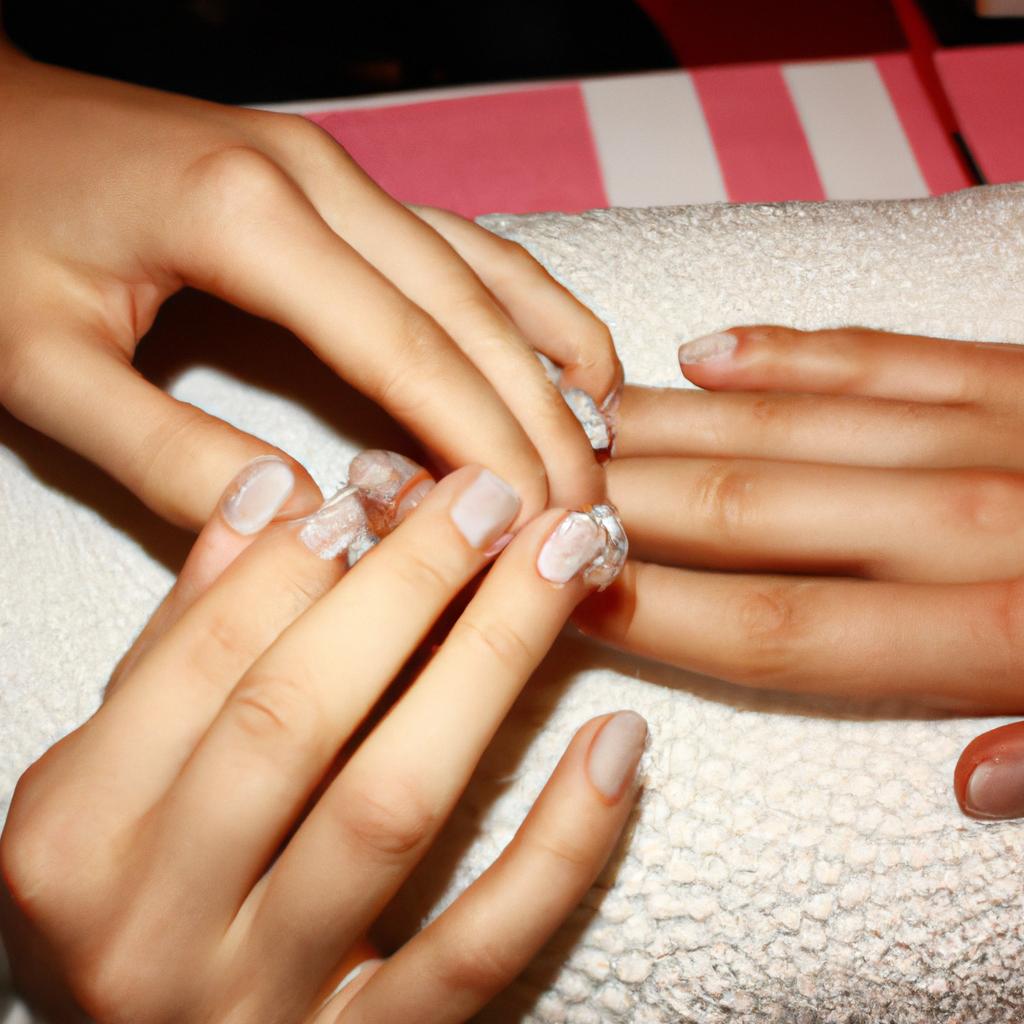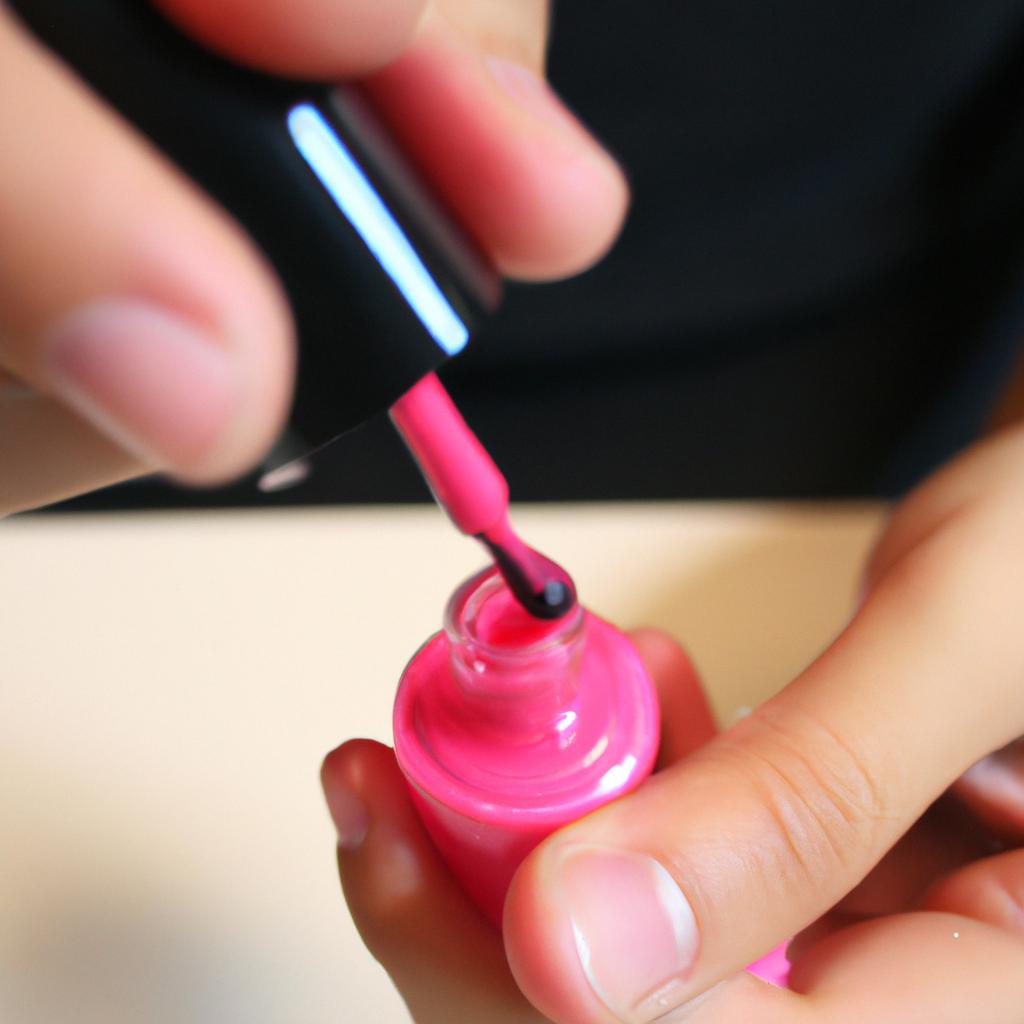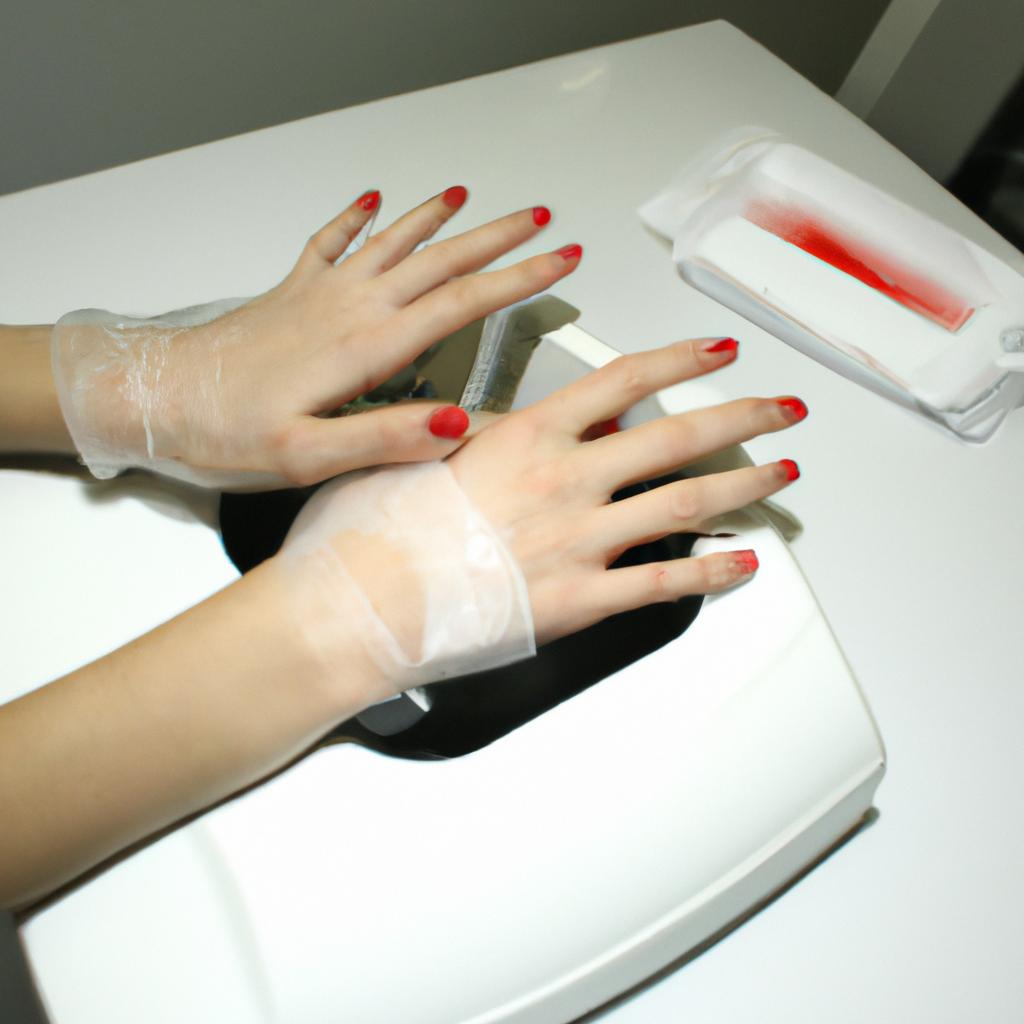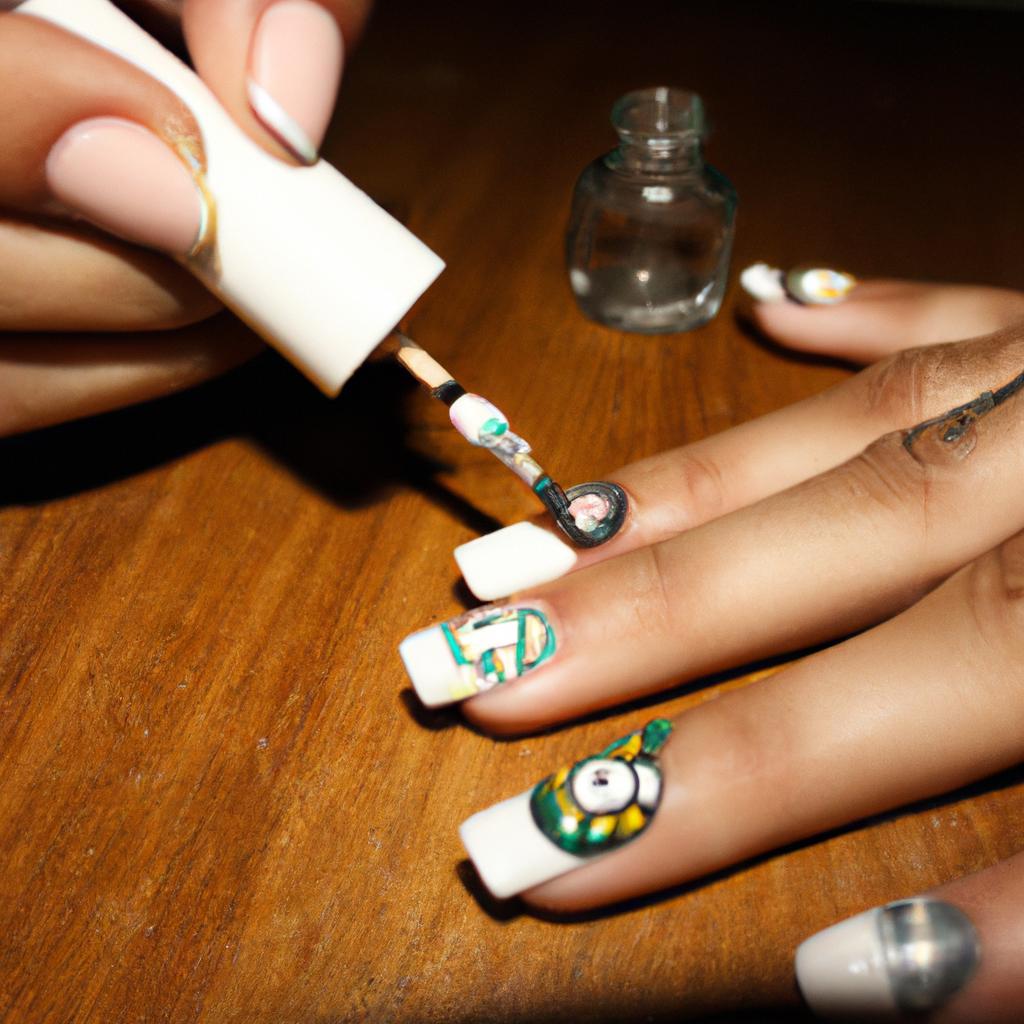Exfoliation for day spa manicures is a vital step in achieving and maintaining healthy, beautiful nails. This informative guide aims to explore the importance of exfoliation in the context of day spa manicures by providing an in-depth analysis of its benefits and techniques. By examining real-life case studies and hypothetical scenarios, this article will delve into the various aspects of exfoliation, including its role in promoting nail health, enhancing nail polish adherence, and improving overall hand appearance.
Imagine a scenario where a client walks into a day spa seeking a rejuvenating manicure experience. Their hands are rough and dry with visible signs of cuticle overgrowth. With expert guidance from a skilled technician who understands the significance of exfoliation, this client’s hands undergo a transformative journey. Through careful application of exfoliating agents such as scrubs or masks, coupled with gentle massaging motions that stimulate blood circulation, their skin becomes smoother and more supple. Not only does this result in enhanced comfort for the client during the treatment process but also contributes to long-lasting effects that extend beyond their time at the spa.
Benefits of exfoliation for healthy nails
Benefits of Exfoliation for Healthy Nails
Imagine a woman named Sarah who regularly visits her local day spa for manicures. Despite diligently taking care of her nails, she has noticed that they often appear dull and lackluster. One day, the nail technician suggests incorporating exfoliation into her routine to enhance the health and appearance of her nails. Intrigued by this recommendation, Sarah decides to give it a try. Little does she know that exfoliation will offer numerous benefits beyond what she initially expected.
Exfoliating the hands and nails not only removes dead skin cells but also promotes blood circulation in the area. By gently scrubbing away the outer layer of skin, fresh new cells are revealed, resulting in smoother and healthier-looking nails. This process can improve both the texture and tone of the skin around the nails, leaving them looking youthful and revitalized.
Moreover, exfoliation enhances the absorption of moisturizers and other nail care products applied afterward. The removal of dead skin allows these products to penetrate more deeply into the underlying layers, maximizing their effectiveness. As a result, regular exfoliation can help prevent dryness, brittleness, and breakage of the nails.
To further illustrate the advantages of exfoliation, consider some key points:
- Improved Nail Health: Exfoliating reduces fungal or bacterial infections on the surface of your nails.
- Enhanced Nail Growth: Regular exfoliation stimulates faster nail growth by promoting healthy blood flow.
- Youthful Appearance: Exfoliated hands with well-maintained cuticles create an overall polished look.
- Relaxation through Self-Care: Incorporating an exfoliation routine into your self-care regimen provides relaxation while achieving beautiful results.
| Improved Nail Health | |
|---|---|
| 1 | Reduces risk of infection |
| 2 | Prevents build-up of bacteria |
| 3 | Eliminates fungal growth |
| 4 | Enhances overall nail hygiene |
As we can see, exfoliation offers a wide array of benefits for healthy nails. By removing dead skin cells, promoting blood circulation, and enhancing the absorption of other nail care products, this simple step can lead to significant improvements in the appearance and wellbeing of your hands and nails.
Transitioning into the subsequent section about different exfoliation techniques for the hands, let’s explore various methods that you can incorporate into your own day spa manicure routine.
Different exfoliation techniques for the hands
Transitioning from the previous section on the benefits of exfoliation, let us now delve into the various techniques available for achieving healthy and rejuvenated hands. To illustrate the effectiveness of these techniques, consider a hypothetical case study of Emma, a regular spa-goer who suffered from dry and dull nails. By incorporating different exfoliation methods into her day spa manicures, Emma witnessed remarkable transformations in both the appearance and overall health of her hands.
To begin with, manual exfoliation involves using physical tools or products to slough off dead skin cells gently. One popular method is scrubbing the hands with a granular exfoliant containing ingredients like sugar or finely ground coffee beans. The gentle abrasion helps remove rough patches while stimulating blood circulation in the fingertips. Additionally, microdermabrasion gloves can be utilized to achieve similar results without any additional products. These textured gloves assist in removing dead skin cells effectively, leaving behind soft and smooth hands.
Chemical exfoliation presents another effective technique for hand rejuvenation. This process often involves using alpha hydroxy acids (AHAs) or enzymes that dissolve dead skin cells chemically. AHAs such as glycolic acid or lactic acid are commonly found in chemical peels designed specifically for hand treatments at spas. These peels work by loosening bonds between old skin cells, revealing fresh layers underneath while promoting collagen production for more youthful-looking hands.
When considering different exfoliation techniques during your day spa manicure experience, it’s essential to understand their unique benefits:
- Manual exfoliation:
- Provides immediate tactile satisfaction.
- Enhances blood circulation.
- Removes rough patches effectively.
- Stimulates natural skin cell turnover.
| Exfoliation Technique | Benefits |
|---|---|
| Manual | – Immediate tactile satisfaction.- Enhanced blood circulation.- Effective removal of rough patches.- Stimulated natural skin cell turnover. |
| Chemical | – Deeper exfoliation for long-lasting results.- Promotes collagen production and youthful appearance.- Targets specific skin concerns like sunspots or hyperpigmentation.- Gentle on sensitive skin. |
By incorporating these techniques into your day spa manicure routine, you can achieve healthier nails and more vibrant hands. With the knowledge gained from this section, let us now explore how to choose the right exfoliating scrub for your specific skin type in our subsequent discussion.
Choosing the right exfoliating scrub for your skin type
Building on the knowledge of different exfoliation techniques for the hands, let us now explore how to choose the right exfoliating scrub for your skin type. To illustrate this, consider a hypothetical scenario where Sara visits a day spa for a manicure and seeks advice from an esthetician about which exfoliating scrub would be most suitable for her dry and sensitive skin.
Sara’s case highlights the importance of selecting an exfoliating scrub that caters specifically to one’s unique skin needs. When choosing an exfoliator for your hands, it is essential to keep in mind factors such as skin type, sensitivity, and desired outcome. Here are some key considerations to help you make an informed decision:
-
Ingredients: Look for scrubs containing natural ingredients like sugar or salt granules, ground coffee beans, oatmeal, or crushed fruit seeds. These gentle yet effective substances provide mechanical exfoliation without causing irritation.
-
Texture: Opt for a scrub with a fine texture that will slough away dead skin cells without being too abrasive. Avoid products with large particles or rough textures, as they can lead to micro-tears in the delicate skin on your hands.
-
Moisturizing Properties: Dry skin types may benefit from using scrubs infused with moisturizing agents like shea butter, coconut oil, or glycerin. These ingredients replenish lost moisture while removing dead skin cells.
-
Fragrance: Consider whether you prefer scented or unscented products. Some people find fragrances relaxing during their spa experience; however, if you have sensitive skin or are prone to allergies, opt for fragrance-free options to avoid potential irritation.
To further illustrate the variety of available choices when it comes to exfoliating scrubs tailored for specific needs and preferences, take a look at the following table:
| Scrub Type | Key Features | Skin Types |
|---|---|---|
| Sugar Scrub | Gentle exfoliation, moisturizing | Dry, sensitive |
| Salt Scrub | Deep cleansing, detoxifying | Oily, combination |
| Coffee Scrub | Stimulating, brightening | Dull, lackluster |
| Fruit Seed Scrub | Natural antioxidants, rejuvenating | All skin types |
Considering these factors and looking for a scrub that aligns with your specific requirements will ensure an effective and enjoyable exfoliating experience. By tailoring the choice of exfoliator to your individual needs, you can achieve optimal results while maintaining the health and integrity of your hands.
Now that we have discussed how to choose the right exfoliating scrub for your skin type, it is crucial to be aware of certain precautions before proceeding with the exfoliation process itself.
Precautions to take before exfoliating your hands
Transitioning from the previous section on choosing the right exfoliating scrub, it is essential to understand the precautions one must take before proceeding with hand exfoliation. By following these necessary steps, you can ensure a safe and effective experience that will leave your hands feeling rejuvenated.
Before delving into the topic further, let’s consider an example. Imagine Jane, someone with sensitive skin who decides to use an exfoliating scrub without conducting a patch test first. Unfortunately, this leads to redness and irritation on her hands, making her regret not taking proper precautions. This example highlights the importance of being cautious when introducing new products or procedures to your skincare routine.
To help you avoid any potential mishaps during hand exfoliation, here are some precautions you should keep in mind:
- Patch Test: Prior to using any new exfoliating product on your hands, perform a patch test on a small area of skin. This simple step can identify any adverse reactions or allergies.
- Avoid Broken Skin: If you have cuts, wounds, or open sores on your hands, it is best to postpone exfoliation until they have healed completely. Exfoliating over damaged skin may cause pain and delay the healing process.
- Gentle Pressure: While exfoliating, remember to apply gentle pressure rather than vigorous scrubbing motions. Aggressive scrubbing can lead to excessive dryness and irritation.
- Moisturize Afterwards: After completing the exfoliation process, moisturizing your hands immediately is crucial for replenishing lost moisture and maintaining their softness.
Now let’s visualize how these precautions contribute to achieving optimal results by considering the following table:
| Precaution | Benefits |
|---|---|
| Patch Test | Identifies allergic reactions early |
| Avoid Broken Skin | Prevents pain and aids in faster healing |
| Gentle Pressure | Protects skin from excessive dryness and irritation |
| Moisturize Afterwards | Replenishes lost moisture and maintains softness |
By implementing these precautions, you can ensure a pleasant exfoliation experience that will leave your hands feeling refreshed and revitalized. Remember to always prioritize the health and well-being of your skin.
In moving forward, an important question arises: “How often should you exfoliate your hands?” Let’s explore this topic in the subsequent section.
How often should you exfoliate your hands?
Transitioning from the previous section on precautions, let’s now delve into understanding how frequently you should exfoliate your hands to maintain their optimal health and appearance. To illustrate this point, consider a hypothetical case study of Sarah, who loves getting day spa manicures. She diligently follows all the necessary precautions before each session but wonders about the ideal frequency for hand exfoliation.
It is crucial to strike a balance when it comes to exfoliating your hands. Over-exfoliation can lead to dryness, irritation, and even damage to the delicate skin. On the other hand, neglecting regular exfoliation may result in the accumulation of dead skin cells and impurities, diminishing the overall effect of your manicure. To help guide you in determining an appropriate frequency for hand exfoliation, here are some key factors to consider:
-
Skin Type: Different individuals have varying levels of sensitivity and oiliness in their skin. Those with sensitive or dry skin types should opt for less frequent exfoliation – once every two weeks or as needed – to prevent excessive drying out of the skin. Conversely, individuals with oily or combination skin might benefit from weekly exfoliation sessions.
-
Lifestyle Factors: Consider your daily activities and exposure to external elements that could impact your hands’ condition. If you engage in manual labor or frequently come into contact with harsh chemicals or dirt, more frequent exfoliation may be required to keep your hands looking clean and fresh.
-
Seasonal Changes: The needs of our skin often fluctuate with seasonal changes. During winter months when humidity levels drop and cold weather prevails, it becomes essential to increase moisturization while reducing the frequency of exfoliation sessions since our skin tends to become drier during this time.
-
Personal Preference: Ultimately, personal preference plays a significant role in establishing an adequate schedule for hand exfoliation. Some individuals may find that a once-a-month session is sufficient, while others might prefer more regular exfoliation as part of their self-care routine.
To help you visualize the recommended frequency based on your skin type and lifestyle factors, here’s a table outlining general guidelines:
| Skin Type | Recommended Exfoliation Frequency |
|---|---|
| Sensitive/Dry | Once every two weeks or as needed |
| Normal/Combination | Once a week |
| Oily | Twice a week |
In summary, finding the right balance for hand exfoliation depends on various factors such as skin type, lifestyle, seasonal changes, and personal preference. By taking these considerations into account and tailoring your approach accordingly, you can maintain well-nourished and rejuvenated hands between day spa manicure sessions.
As we now understand how often to exfoliate our hands effectively, let’s explore other complementary spa treatments that can enhance the overall indulgence of your manicure experience.
Other spa treatments to complement your exfoliating manicure
Having understood the importance of regular exfoliation for maintaining smooth and healthy hands, it is worth exploring other spa treatments that can enhance the overall experience of a day spa manicure. By incorporating these additional treatments alongside exfoliation, you can achieve an even more rejuvenating and luxurious pampering session.
Example: Consider Sarah, who visits her favorite day spa for a manicure treatment. After receiving an invigorating exfoliation for her hands, she decides to indulge in some complementary spa treatments to elevate her experience further.
Paragraph 1:
One popular option to accompany an exfoliating manicure is paraffin wax treatment. This therapy involves immersing the hands into warm melted paraffin wax, which helps moisturize the skin deeply while also soothing tired muscles and joints. The warmth from the wax enhances blood circulation, promoting relaxation and relieving stiffness. Additionally, paraffin wax forms a protective barrier on the skin’s surface, locking in moisture and leaving the hands feeling supple and soft.
Paragraph 2:
Another beneficial addition to an exfoliating manicure is a hand massage using essential oils. Essential oils have long been used for their therapeutic properties and can provide various benefits during a hand massage. Lavender oil, known for its calming scent, promotes relaxation and reduces stress levels. Peppermint oil has cooling properties that refresh tired hands, while citrus-based oils uplift moods with their cheerful aroma. A gentle yet firm hand massage with these oils not only nourishes the skin but also stimulates pressure points, improving overall well-being.
Paragraph 3:
To complete your indulgent spa experience after an exfoliating manicure, consider adding nail art or applying gel polish as a finishing touch. Nail art allows you to express creativity through intricate designs or simple patterns that reflect your personal style. On the other hand (no pun intended), gel polish offers a longer-lasting alternative to traditional nail lacquer, ensuring your manicure remains flawless for an extended period. These enhancements not only enhance the aesthetic appeal of your hands but also boost self-confidence and provide a sense of satisfaction.
- Feel pampered and cared for with additional spa treatments.
- Experience deep relaxation through paraffin wax therapy.
- Indulge in the soothing scents of essential oils during a hand massage.
- Express creativity or enjoy long-lasting nails with nail art or gel polish.
| Spa Treatment | Benefits |
|---|---|
| Paraffin Wax | – Deeply moisturizes |
| – Soothes muscles and joints | |
| – Improves blood circulation | |
| Essential Oils | – Calms and reduces stress |
| Hand Massage | – Refreshes tired hands |
| – Uplifts mood | |
| Nail Art | – Allows creativity expression |
| Gel Polish | – Provides long-lasting perfection |
In conclusion, by adding complementary spa treatments such as paraffin wax therapy, hand massages using essential oils, and options like nail art or gel polish to accompany exfoliating manicures, you can elevate your day spa experience. These additional treatments offer various benefits ranging from relaxation and moisturization to creative expression and long-lasting beauty. Embrace these options to make each visit to the day spa truly indulgent and rejuvenating.




